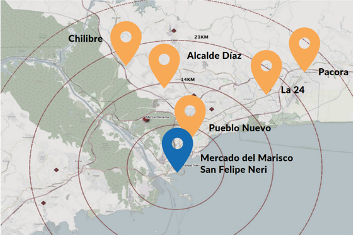The San Felipe Neri Public Market as a Circular Economy Lab in Panama City
March 13, 2023
99% of the waste generated by the San Felipe Neri Public Market —nicknamed el Neri— may be repurposed. Can the public markets of the future follow a circular economy model?
From its former home on Panama City’s old embankment, the San Felipe Neri Public Market (MSFN for its Spanish acronym) has been part and parcel or our city’s heart and a key space providing food security to its surrounding communities. Today, despite its recent renovation, el Neri must reestablish its former relevance.

The San Felipe Neri Public Market on Panama City’s old embankment.
El Neri has a lot to teach us. In the context of developing the Integrated Municipal Public Markets Network (RIMMU for its Spanish acronym), the UNDP Accelerator Lab —together with Panama City’s Public Markets Department and Re-inventa—carried out a four-phase learning process in which el Neri has become a Circular Economy Lab to inform the development of Panama City’s integrated markets network.

Public markets within the Integrated Municipal Public Markets Network in relation to the San Felipe Neri Public Market. | March 2022
In this blog we will tell you a little bit more about the first phase of our learning process, which focused on establishing a baseline on the waste generated by el Neri and, from there, thinking about alternative uses for this “waste” based on the circular economy concept, which Panamanian legislation defines as “A model of production and consumption that involves sharing, renting, reusing, repairing, renovating and recycling existing materials and products as often as possible to create added value”.

Phases of our learning process at the San Felipe Neri Public Market
Our process aims to rethink how we can achieve such circular economy ideal through transformative participation, opening the market’s doors to explore and experiment, together with el Neri’s ecosystem of market actors and the territory to which it belongs.

Main entrance of the San Felipe de Neri Public Market in Panama City’s Santa Ana neighborhood.
Our point of departure
To determine a baseline, we established an alliance with the National Movement of Panamanian Recyclers who, thanks to their knowledge, trained a municipal team on waste characterization processes and the collection of data and information on waste generation.

The National Movement of Panamanian Recyclers’ team, which trained el Neri’s municipal personnel and carried out waste characterizations in the San Felipe Neri Public Market.
The National Movement of Panamanian Recyclers also developed a data collection tool for us and a prototype information system to perform data analyses. Check this tool here.

Waste data validation and registration team at the San Felipe Neri Public Market.

Waste data validation and registration team at the San Felipe Neri Public Market.
Then, we got down to work. After more than sixteen hours sorting, weighing, and recording over 2.5 metric tons of waste from 86 market stores, this is what we learned:

Waste data validation and registration team at the San Felipe Neri Public Market.
99% of el Neri’s waste is recyclable. Of this percentage, more than 80% is organic and more than 6% includes other recyclable materials, such as plastic.
This data reveals a great opportunity to significantly reduce waste generation in el Neri, with a deliberate focus on recovering food and reusing and/or processing other materials that could have further use.
Could the public markets of the future generate zero waste?
Waste characterization at el Neri allowed us to have an evidence-based point of departure to analyze the data and measure the impact of solutions focused on generating a circular economy.
Our prototype is the first model of an information system on solid waste generation at an institutional level —based on Law 276 of 2021— which could be incorporated into the Integrated Municipal Public Markets Network to develop an advanced information system for all the public markets that are in the process of being built.
This blog is part of a series on learning activities and reflections generated by the UNDP Accelerator Labs, together with the Public Markets Bureau of the Municipality of Panama and the Panamanian non-profit Re-inventa, within the context of developing the Integrated Municipal Public Markets Network (RIMMU for its Spanish acronym). To learn more about our methodology and process, please feel free to read our full series.

 Locations
Locations
